TFIN204: Transformation of Credit Unions After Deregulation Era
VerifiedAdded on 2022/11/13
|14
|2743
|221
Report
AI Summary
This report examines the transformation of Australia's financial sector following deregulation in the 1980s, focusing on the shift of credit unions and building societies into banks. It discusses how government regulations prior to deregulation hindered competition and innovation within the financial sector. The report analyzes the rationale behind the change, including the quest for scale and the ability to offer a wider range of banking services. Mergers among credit unions and building societies are highlighted as a key strategy for survival and competitiveness, leading to the formation of larger banking entities. The implications of this transformation, such as increased competition and efficiency in the financial sector, are also explored. The report concludes by emphasizing the positive impact of deregulation on the financial industry's contribution to Australia's economic growth and recommends continued support for credit unions and building societies transitioning into banks.
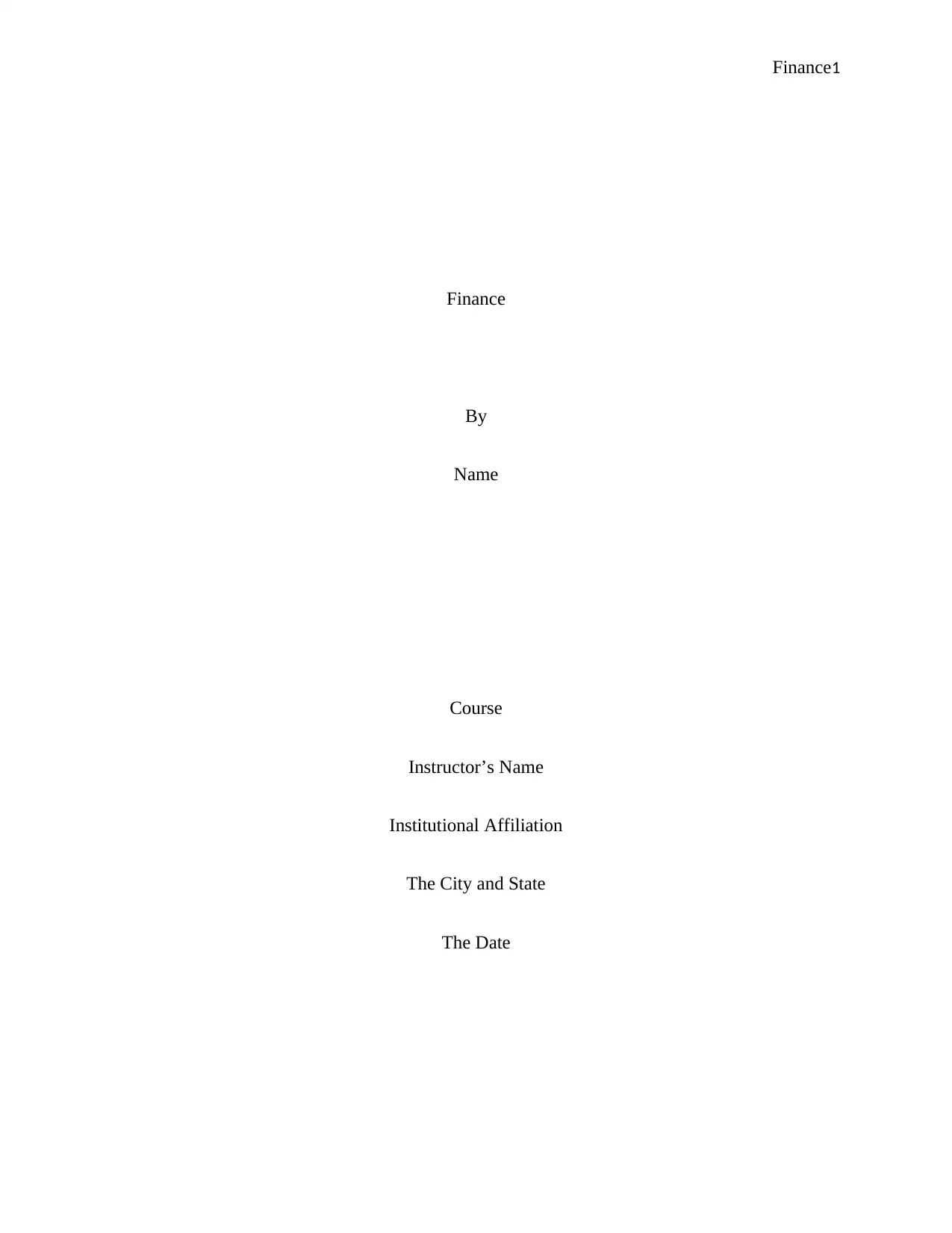
Finance1
Finance
By
Name
Course
Instructor’s Name
Institutional Affiliation
The City and State
The Date
Finance
By
Name
Course
Instructor’s Name
Institutional Affiliation
The City and State
The Date
Paraphrase This Document
Need a fresh take? Get an instant paraphrase of this document with our AI Paraphraser
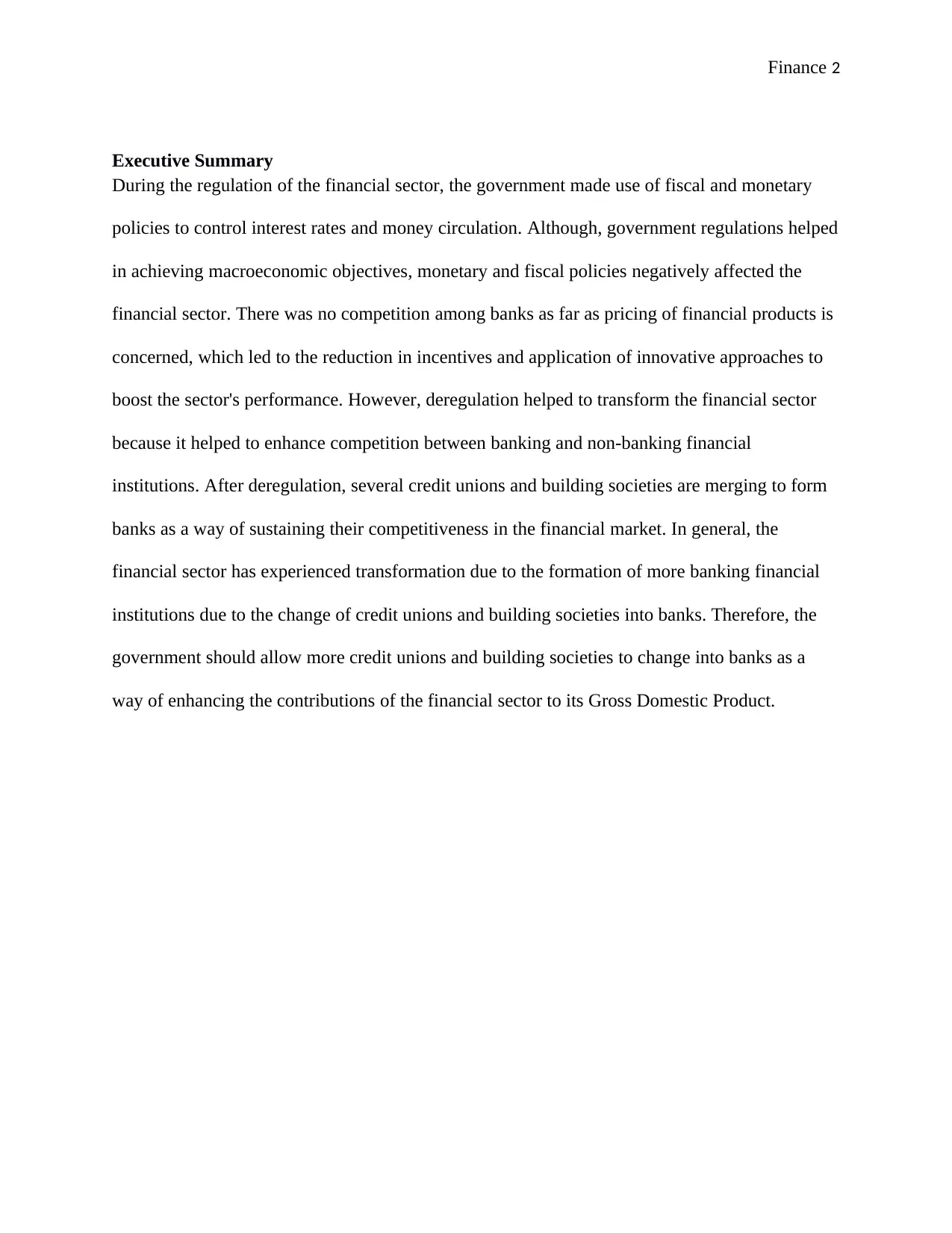
Finance 2
Executive Summary
During the regulation of the financial sector, the government made use of fiscal and monetary
policies to control interest rates and money circulation. Although, government regulations helped
in achieving macroeconomic objectives, monetary and fiscal policies negatively affected the
financial sector. There was no competition among banks as far as pricing of financial products is
concerned, which led to the reduction in incentives and application of innovative approaches to
boost the sector's performance. However, deregulation helped to transform the financial sector
because it helped to enhance competition between banking and non-banking financial
institutions. After deregulation, several credit unions and building societies are merging to form
banks as a way of sustaining their competitiveness in the financial market. In general, the
financial sector has experienced transformation due to the formation of more banking financial
institutions due to the change of credit unions and building societies into banks. Therefore, the
government should allow more credit unions and building societies to change into banks as a
way of enhancing the contributions of the financial sector to its Gross Domestic Product.
Executive Summary
During the regulation of the financial sector, the government made use of fiscal and monetary
policies to control interest rates and money circulation. Although, government regulations helped
in achieving macroeconomic objectives, monetary and fiscal policies negatively affected the
financial sector. There was no competition among banks as far as pricing of financial products is
concerned, which led to the reduction in incentives and application of innovative approaches to
boost the sector's performance. However, deregulation helped to transform the financial sector
because it helped to enhance competition between banking and non-banking financial
institutions. After deregulation, several credit unions and building societies are merging to form
banks as a way of sustaining their competitiveness in the financial market. In general, the
financial sector has experienced transformation due to the formation of more banking financial
institutions due to the change of credit unions and building societies into banks. Therefore, the
government should allow more credit unions and building societies to change into banks as a
way of enhancing the contributions of the financial sector to its Gross Domestic Product.
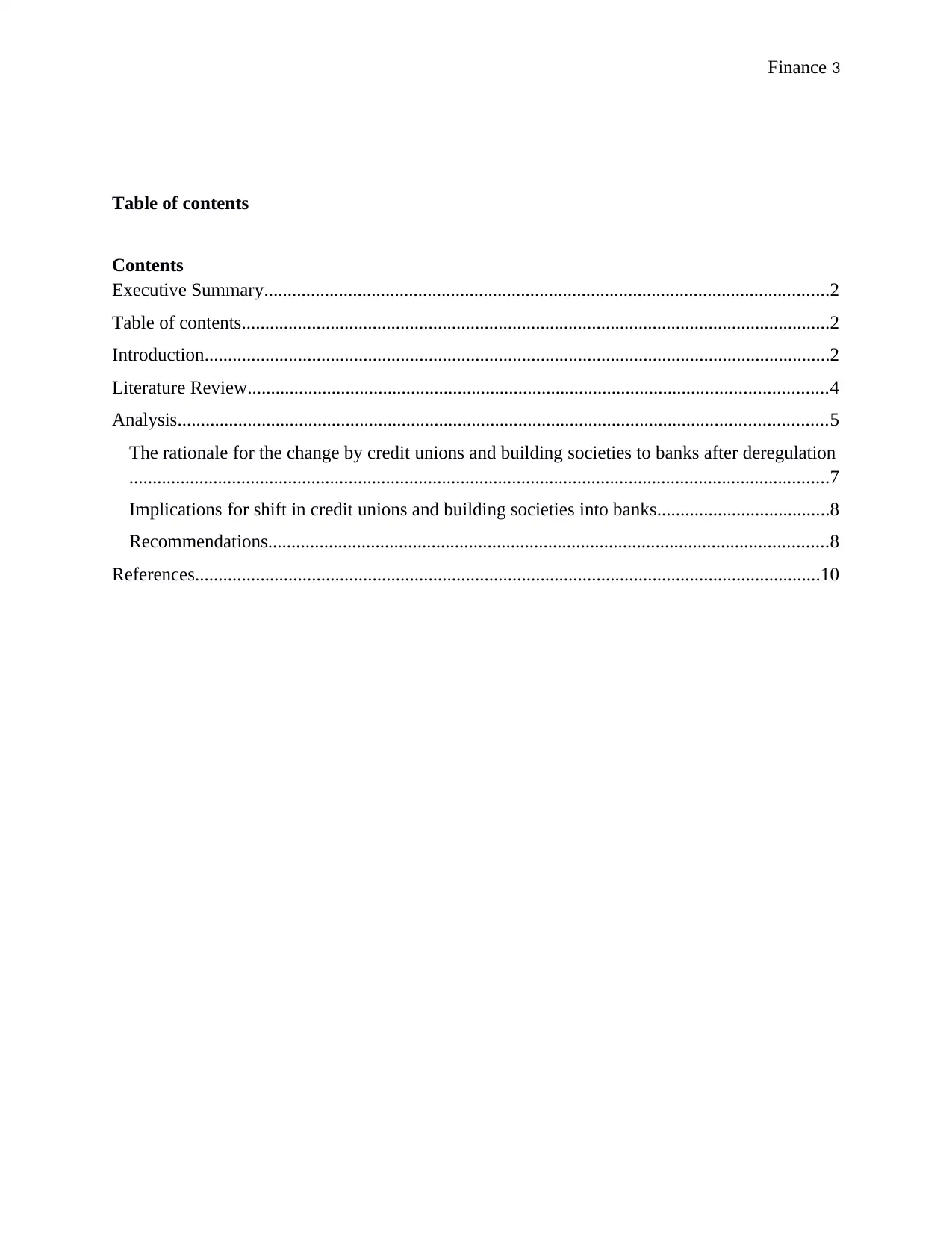
Finance 3
Table of contents
Contents
Executive Summary.........................................................................................................................2
Table of contents..............................................................................................................................2
Introduction......................................................................................................................................2
Literature Review............................................................................................................................4
Analysis...........................................................................................................................................5
The rationale for the change by credit unions and building societies to banks after deregulation
......................................................................................................................................................7
Implications for shift in credit unions and building societies into banks.....................................8
Recommendations........................................................................................................................8
References......................................................................................................................................10
Table of contents
Contents
Executive Summary.........................................................................................................................2
Table of contents..............................................................................................................................2
Introduction......................................................................................................................................2
Literature Review............................................................................................................................4
Analysis...........................................................................................................................................5
The rationale for the change by credit unions and building societies to banks after deregulation
......................................................................................................................................................7
Implications for shift in credit unions and building societies into banks.....................................8
Recommendations........................................................................................................................8
References......................................................................................................................................10
⊘ This is a preview!⊘
Do you want full access?
Subscribe today to unlock all pages.

Trusted by 1+ million students worldwide

Finance 4
Introduction
Australia's financial sector is made up of banking and non-banking financial institutions
which play a role of mobilizing and allocating savings within the commercial atmosphere. These
institutions accept savings from investors and individuals within communities as a way of
facilitating transactions within Australia's financial markets. To cater for prospective economic
uncertainties, financial institutions are offering payment services through sharing and pooling of
risks. A financial sector is referred to as regulated when the government manages and control all
events that take place in it using policies like fiscal and monetary policies. In most case, the
government may opt to use fiscal policy as a way of controlling interest rates and lending within
the financial sector to achieve set economic objectives (Productivity Commission 2011). In
response, all financial institutions, either banking or non-banking, are required to act according
to the interests of the government through its fiscal or monetary policies.
However, a financial sector that has no or limited government control and regulations is
said to be deregulated. In such a case, all banking and non-banking financial institution can
determine their methods of operation with any influence from government policies. Australia is
one of the countries across the world that deregulated its financial sector in the 1980s as a way of
enhancing the sector potential and contributions towards its Gross Domestic Product (GDP).
Moreover, government regulations had significantly affected the performance of banking and
non-banking financial institutions which had deteriorated contributions of the financial sector to
its GDP during the post world war II period till the 1970s. Credit Unions and building societies
were the primary institutions that formed the non-banking part of the financial sector, whereas
banks dominated the banking portion of the financial sector (Douglas 2017 p. 60). Most
significantly, the number of credit unions and building societies has been deteriorating ever since
Introduction
Australia's financial sector is made up of banking and non-banking financial institutions
which play a role of mobilizing and allocating savings within the commercial atmosphere. These
institutions accept savings from investors and individuals within communities as a way of
facilitating transactions within Australia's financial markets. To cater for prospective economic
uncertainties, financial institutions are offering payment services through sharing and pooling of
risks. A financial sector is referred to as regulated when the government manages and control all
events that take place in it using policies like fiscal and monetary policies. In most case, the
government may opt to use fiscal policy as a way of controlling interest rates and lending within
the financial sector to achieve set economic objectives (Productivity Commission 2011). In
response, all financial institutions, either banking or non-banking, are required to act according
to the interests of the government through its fiscal or monetary policies.
However, a financial sector that has no or limited government control and regulations is
said to be deregulated. In such a case, all banking and non-banking financial institution can
determine their methods of operation with any influence from government policies. Australia is
one of the countries across the world that deregulated its financial sector in the 1980s as a way of
enhancing the sector potential and contributions towards its Gross Domestic Product (GDP).
Moreover, government regulations had significantly affected the performance of banking and
non-banking financial institutions which had deteriorated contributions of the financial sector to
its GDP during the post world war II period till the 1970s. Credit Unions and building societies
were the primary institutions that formed the non-banking part of the financial sector, whereas
banks dominated the banking portion of the financial sector (Douglas 2017 p. 60). Most
significantly, the number of credit unions and building societies has been deteriorating ever since
Paraphrase This Document
Need a fresh take? Get an instant paraphrase of this document with our AI Paraphraser
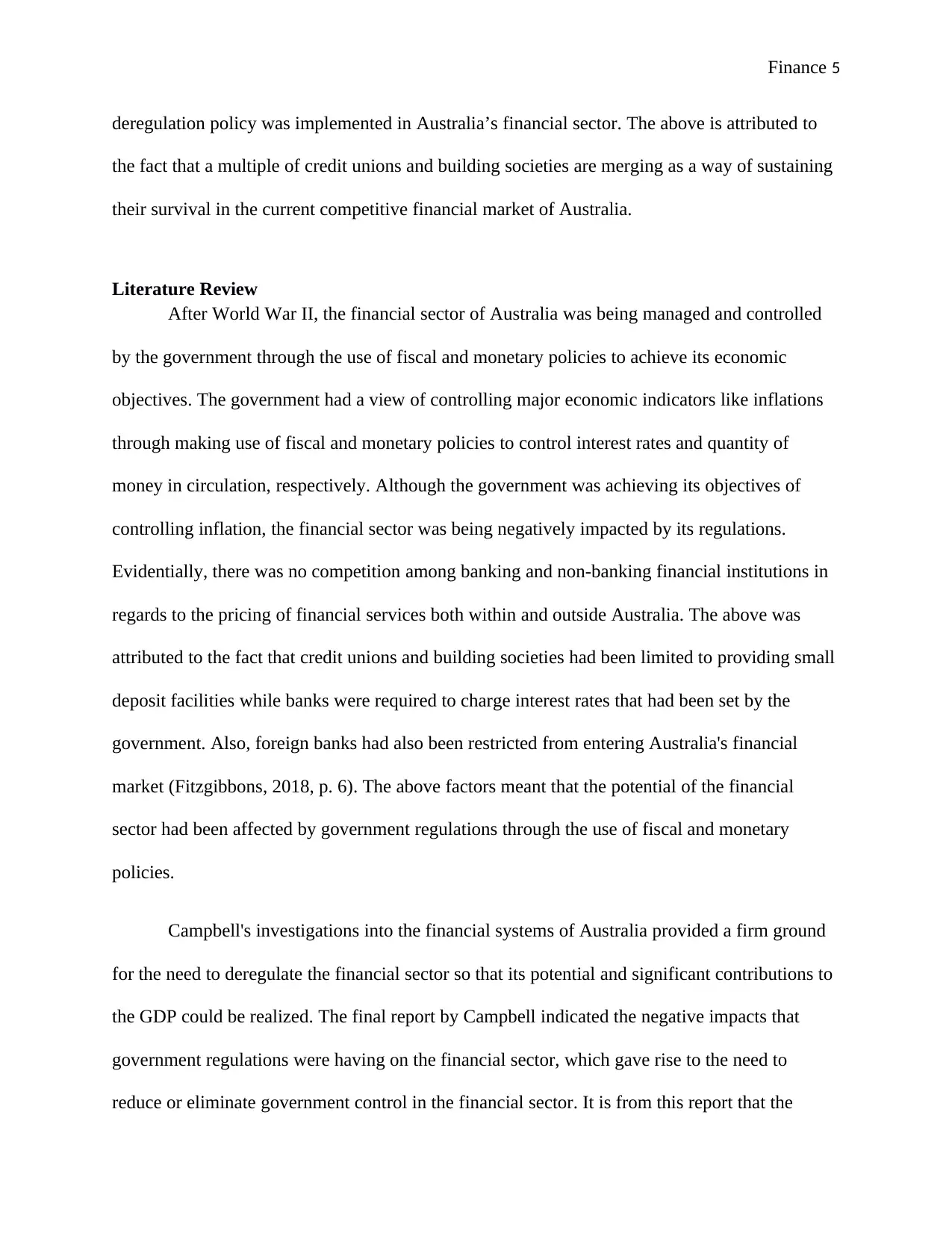
Finance 5
deregulation policy was implemented in Australia’s financial sector. The above is attributed to
the fact that a multiple of credit unions and building societies are merging as a way of sustaining
their survival in the current competitive financial market of Australia.
Literature Review
After World War II, the financial sector of Australia was being managed and controlled
by the government through the use of fiscal and monetary policies to achieve its economic
objectives. The government had a view of controlling major economic indicators like inflations
through making use of fiscal and monetary policies to control interest rates and quantity of
money in circulation, respectively. Although the government was achieving its objectives of
controlling inflation, the financial sector was being negatively impacted by its regulations.
Evidentially, there was no competition among banking and non-banking financial institutions in
regards to the pricing of financial services both within and outside Australia. The above was
attributed to the fact that credit unions and building societies had been limited to providing small
deposit facilities while banks were required to charge interest rates that had been set by the
government. Also, foreign banks had also been restricted from entering Australia's financial
market (Fitzgibbons, 2018, p. 6). The above factors meant that the potential of the financial
sector had been affected by government regulations through the use of fiscal and monetary
policies.
Campbell's investigations into the financial systems of Australia provided a firm ground
for the need to deregulate the financial sector so that its potential and significant contributions to
the GDP could be realized. The final report by Campbell indicated the negative impacts that
government regulations were having on the financial sector, which gave rise to the need to
reduce or eliminate government control in the financial sector. It is from this report that the
deregulation policy was implemented in Australia’s financial sector. The above is attributed to
the fact that a multiple of credit unions and building societies are merging as a way of sustaining
their survival in the current competitive financial market of Australia.
Literature Review
After World War II, the financial sector of Australia was being managed and controlled
by the government through the use of fiscal and monetary policies to achieve its economic
objectives. The government had a view of controlling major economic indicators like inflations
through making use of fiscal and monetary policies to control interest rates and quantity of
money in circulation, respectively. Although the government was achieving its objectives of
controlling inflation, the financial sector was being negatively impacted by its regulations.
Evidentially, there was no competition among banking and non-banking financial institutions in
regards to the pricing of financial services both within and outside Australia. The above was
attributed to the fact that credit unions and building societies had been limited to providing small
deposit facilities while banks were required to charge interest rates that had been set by the
government. Also, foreign banks had also been restricted from entering Australia's financial
market (Fitzgibbons, 2018, p. 6). The above factors meant that the potential of the financial
sector had been affected by government regulations through the use of fiscal and monetary
policies.
Campbell's investigations into the financial systems of Australia provided a firm ground
for the need to deregulate the financial sector so that its potential and significant contributions to
the GDP could be realized. The final report by Campbell indicated the negative impacts that
government regulations were having on the financial sector, which gave rise to the need to
reduce or eliminate government control in the financial sector. It is from this report that the
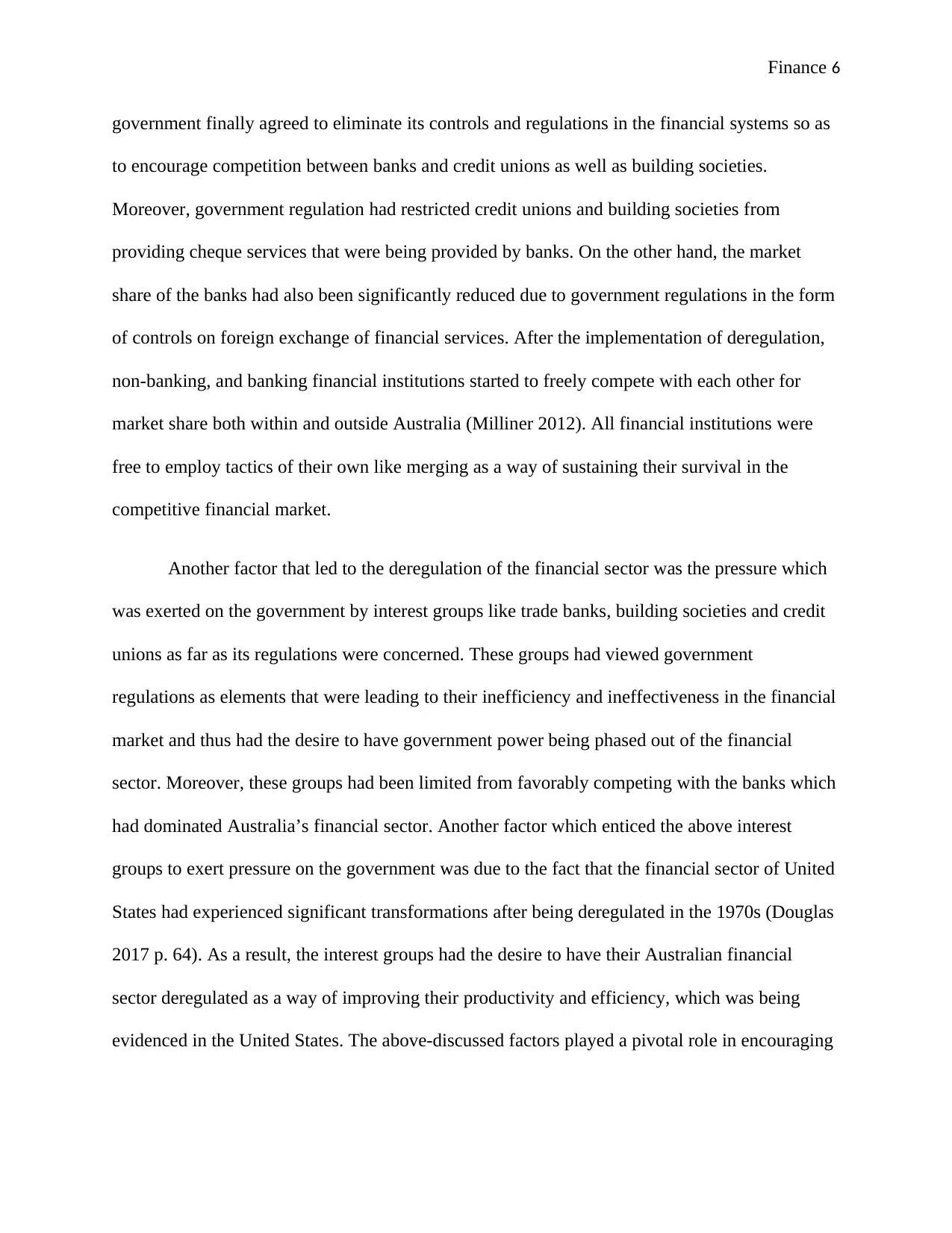
Finance 6
government finally agreed to eliminate its controls and regulations in the financial systems so as
to encourage competition between banks and credit unions as well as building societies.
Moreover, government regulation had restricted credit unions and building societies from
providing cheque services that were being provided by banks. On the other hand, the market
share of the banks had also been significantly reduced due to government regulations in the form
of controls on foreign exchange of financial services. After the implementation of deregulation,
non-banking, and banking financial institutions started to freely compete with each other for
market share both within and outside Australia (Milliner 2012). All financial institutions were
free to employ tactics of their own like merging as a way of sustaining their survival in the
competitive financial market.
Another factor that led to the deregulation of the financial sector was the pressure which
was exerted on the government by interest groups like trade banks, building societies and credit
unions as far as its regulations were concerned. These groups had viewed government
regulations as elements that were leading to their inefficiency and ineffectiveness in the financial
market and thus had the desire to have government power being phased out of the financial
sector. Moreover, these groups had been limited from favorably competing with the banks which
had dominated Australia’s financial sector. Another factor which enticed the above interest
groups to exert pressure on the government was due to the fact that the financial sector of United
States had experienced significant transformations after being deregulated in the 1970s (Douglas
2017 p. 64). As a result, the interest groups had the desire to have their Australian financial
sector deregulated as a way of improving their productivity and efficiency, which was being
evidenced in the United States. The above-discussed factors played a pivotal role in encouraging
government finally agreed to eliminate its controls and regulations in the financial systems so as
to encourage competition between banks and credit unions as well as building societies.
Moreover, government regulation had restricted credit unions and building societies from
providing cheque services that were being provided by banks. On the other hand, the market
share of the banks had also been significantly reduced due to government regulations in the form
of controls on foreign exchange of financial services. After the implementation of deregulation,
non-banking, and banking financial institutions started to freely compete with each other for
market share both within and outside Australia (Milliner 2012). All financial institutions were
free to employ tactics of their own like merging as a way of sustaining their survival in the
competitive financial market.
Another factor that led to the deregulation of the financial sector was the pressure which
was exerted on the government by interest groups like trade banks, building societies and credit
unions as far as its regulations were concerned. These groups had viewed government
regulations as elements that were leading to their inefficiency and ineffectiveness in the financial
market and thus had the desire to have government power being phased out of the financial
sector. Moreover, these groups had been limited from favorably competing with the banks which
had dominated Australia’s financial sector. Another factor which enticed the above interest
groups to exert pressure on the government was due to the fact that the financial sector of United
States had experienced significant transformations after being deregulated in the 1970s (Douglas
2017 p. 64). As a result, the interest groups had the desire to have their Australian financial
sector deregulated as a way of improving their productivity and efficiency, which was being
evidenced in the United States. The above-discussed factors played a pivotal role in encouraging
⊘ This is a preview!⊘
Do you want full access?
Subscribe today to unlock all pages.

Trusted by 1+ million students worldwide
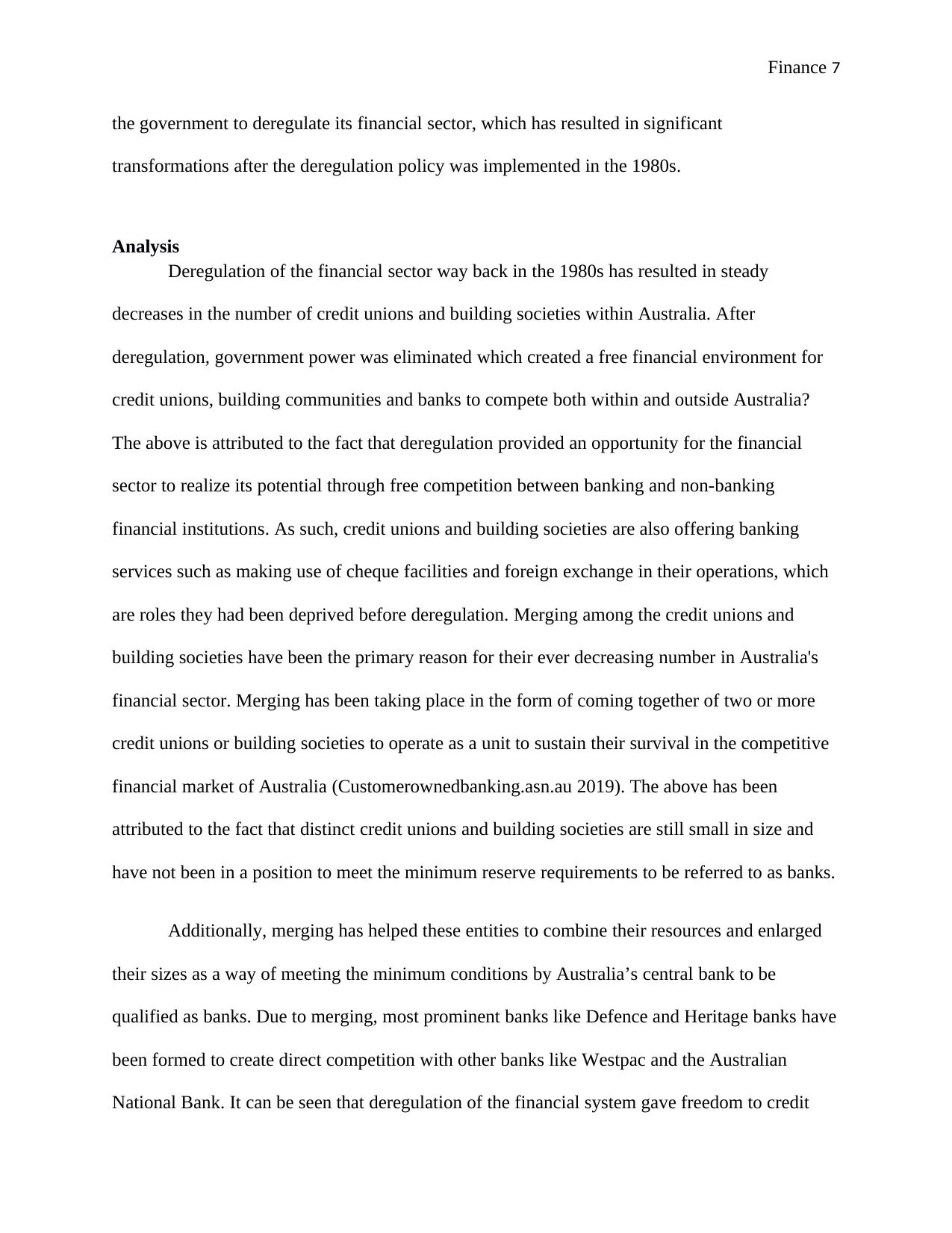
Finance 7
the government to deregulate its financial sector, which has resulted in significant
transformations after the deregulation policy was implemented in the 1980s.
Analysis
Deregulation of the financial sector way back in the 1980s has resulted in steady
decreases in the number of credit unions and building societies within Australia. After
deregulation, government power was eliminated which created a free financial environment for
credit unions, building communities and banks to compete both within and outside Australia?
The above is attributed to the fact that deregulation provided an opportunity for the financial
sector to realize its potential through free competition between banking and non-banking
financial institutions. As such, credit unions and building societies are also offering banking
services such as making use of cheque facilities and foreign exchange in their operations, which
are roles they had been deprived before deregulation. Merging among the credit unions and
building societies have been the primary reason for their ever decreasing number in Australia's
financial sector. Merging has been taking place in the form of coming together of two or more
credit unions or building societies to operate as a unit to sustain their survival in the competitive
financial market of Australia (Customerownedbanking.asn.au 2019). The above has been
attributed to the fact that distinct credit unions and building societies are still small in size and
have not been in a position to meet the minimum reserve requirements to be referred to as banks.
Additionally, merging has helped these entities to combine their resources and enlarged
their sizes as a way of meeting the minimum conditions by Australia’s central bank to be
qualified as banks. Due to merging, most prominent banks like Defence and Heritage banks have
been formed to create direct competition with other banks like Westpac and the Australian
National Bank. It can be seen that deregulation of the financial system gave freedom to credit
the government to deregulate its financial sector, which has resulted in significant
transformations after the deregulation policy was implemented in the 1980s.
Analysis
Deregulation of the financial sector way back in the 1980s has resulted in steady
decreases in the number of credit unions and building societies within Australia. After
deregulation, government power was eliminated which created a free financial environment for
credit unions, building communities and banks to compete both within and outside Australia?
The above is attributed to the fact that deregulation provided an opportunity for the financial
sector to realize its potential through free competition between banking and non-banking
financial institutions. As such, credit unions and building societies are also offering banking
services such as making use of cheque facilities and foreign exchange in their operations, which
are roles they had been deprived before deregulation. Merging among the credit unions and
building societies have been the primary reason for their ever decreasing number in Australia's
financial sector. Merging has been taking place in the form of coming together of two or more
credit unions or building societies to operate as a unit to sustain their survival in the competitive
financial market of Australia (Customerownedbanking.asn.au 2019). The above has been
attributed to the fact that distinct credit unions and building societies are still small in size and
have not been in a position to meet the minimum reserve requirements to be referred to as banks.
Additionally, merging has helped these entities to combine their resources and enlarged
their sizes as a way of meeting the minimum conditions by Australia’s central bank to be
qualified as banks. Due to merging, most prominent banks like Defence and Heritage banks have
been formed to create direct competition with other banks like Westpac and the Australian
National Bank. It can be seen that deregulation of the financial system gave freedom to credit
Paraphrase This Document
Need a fresh take? Get an instant paraphrase of this document with our AI Paraphraser
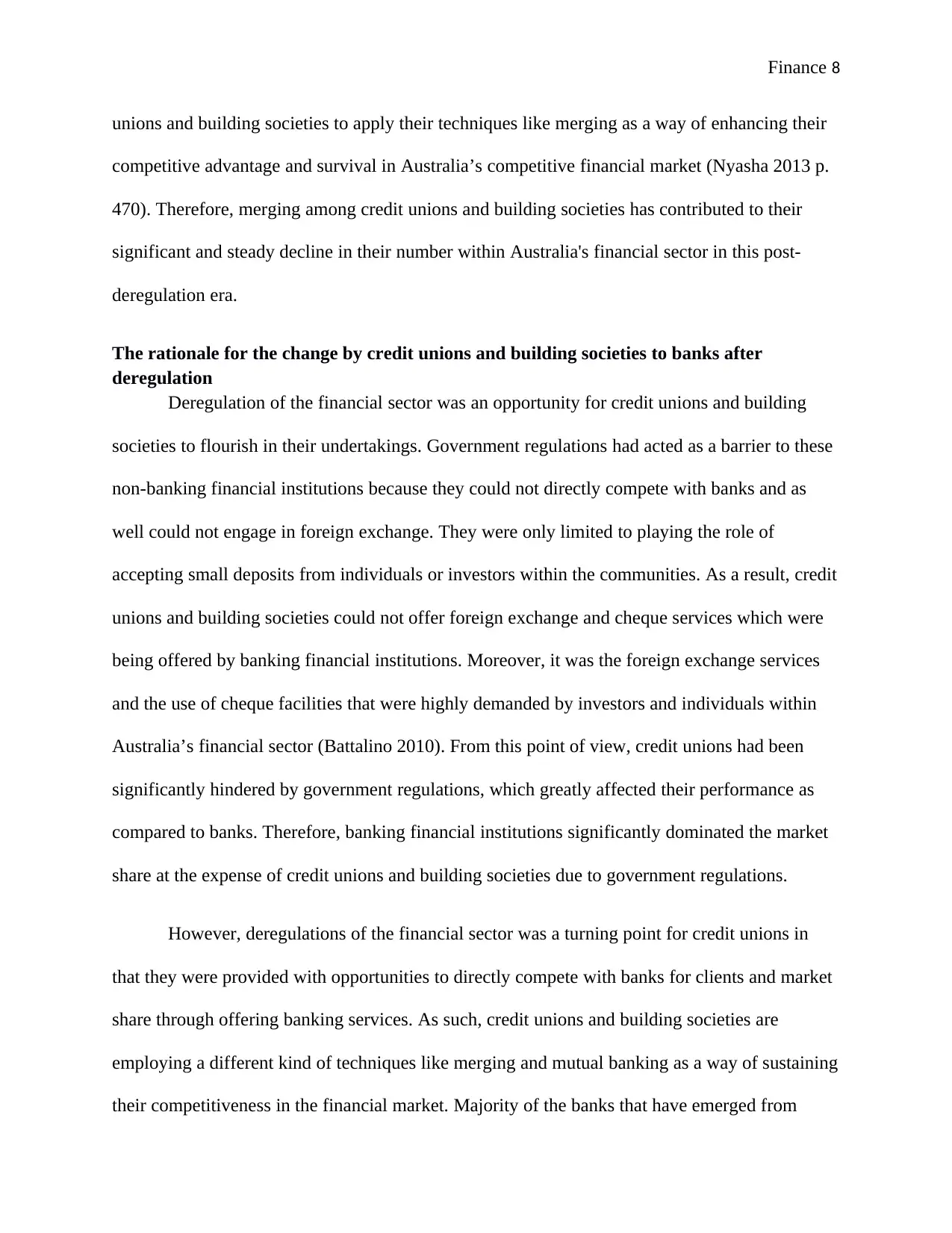
Finance 8
unions and building societies to apply their techniques like merging as a way of enhancing their
competitive advantage and survival in Australia’s competitive financial market (Nyasha 2013 p.
470). Therefore, merging among credit unions and building societies has contributed to their
significant and steady decline in their number within Australia's financial sector in this post-
deregulation era.
The rationale for the change by credit unions and building societies to banks after
deregulation
Deregulation of the financial sector was an opportunity for credit unions and building
societies to flourish in their undertakings. Government regulations had acted as a barrier to these
non-banking financial institutions because they could not directly compete with banks and as
well could not engage in foreign exchange. They were only limited to playing the role of
accepting small deposits from individuals or investors within the communities. As a result, credit
unions and building societies could not offer foreign exchange and cheque services which were
being offered by banking financial institutions. Moreover, it was the foreign exchange services
and the use of cheque facilities that were highly demanded by investors and individuals within
Australia’s financial sector (Battalino 2010). From this point of view, credit unions had been
significantly hindered by government regulations, which greatly affected their performance as
compared to banks. Therefore, banking financial institutions significantly dominated the market
share at the expense of credit unions and building societies due to government regulations.
However, deregulations of the financial sector was a turning point for credit unions in
that they were provided with opportunities to directly compete with banks for clients and market
share through offering banking services. As such, credit unions and building societies are
employing a different kind of techniques like merging and mutual banking as a way of sustaining
their competitiveness in the financial market. Majority of the banks that have emerged from
unions and building societies to apply their techniques like merging as a way of enhancing their
competitive advantage and survival in Australia’s competitive financial market (Nyasha 2013 p.
470). Therefore, merging among credit unions and building societies has contributed to their
significant and steady decline in their number within Australia's financial sector in this post-
deregulation era.
The rationale for the change by credit unions and building societies to banks after
deregulation
Deregulation of the financial sector was an opportunity for credit unions and building
societies to flourish in their undertakings. Government regulations had acted as a barrier to these
non-banking financial institutions because they could not directly compete with banks and as
well could not engage in foreign exchange. They were only limited to playing the role of
accepting small deposits from individuals or investors within the communities. As a result, credit
unions and building societies could not offer foreign exchange and cheque services which were
being offered by banking financial institutions. Moreover, it was the foreign exchange services
and the use of cheque facilities that were highly demanded by investors and individuals within
Australia’s financial sector (Battalino 2010). From this point of view, credit unions had been
significantly hindered by government regulations, which greatly affected their performance as
compared to banks. Therefore, banking financial institutions significantly dominated the market
share at the expense of credit unions and building societies due to government regulations.
However, deregulations of the financial sector was a turning point for credit unions in
that they were provided with opportunities to directly compete with banks for clients and market
share through offering banking services. As such, credit unions and building societies are
employing a different kind of techniques like merging and mutual banking as a way of sustaining
their competitiveness in the financial market. Majority of the banks that have emerged from
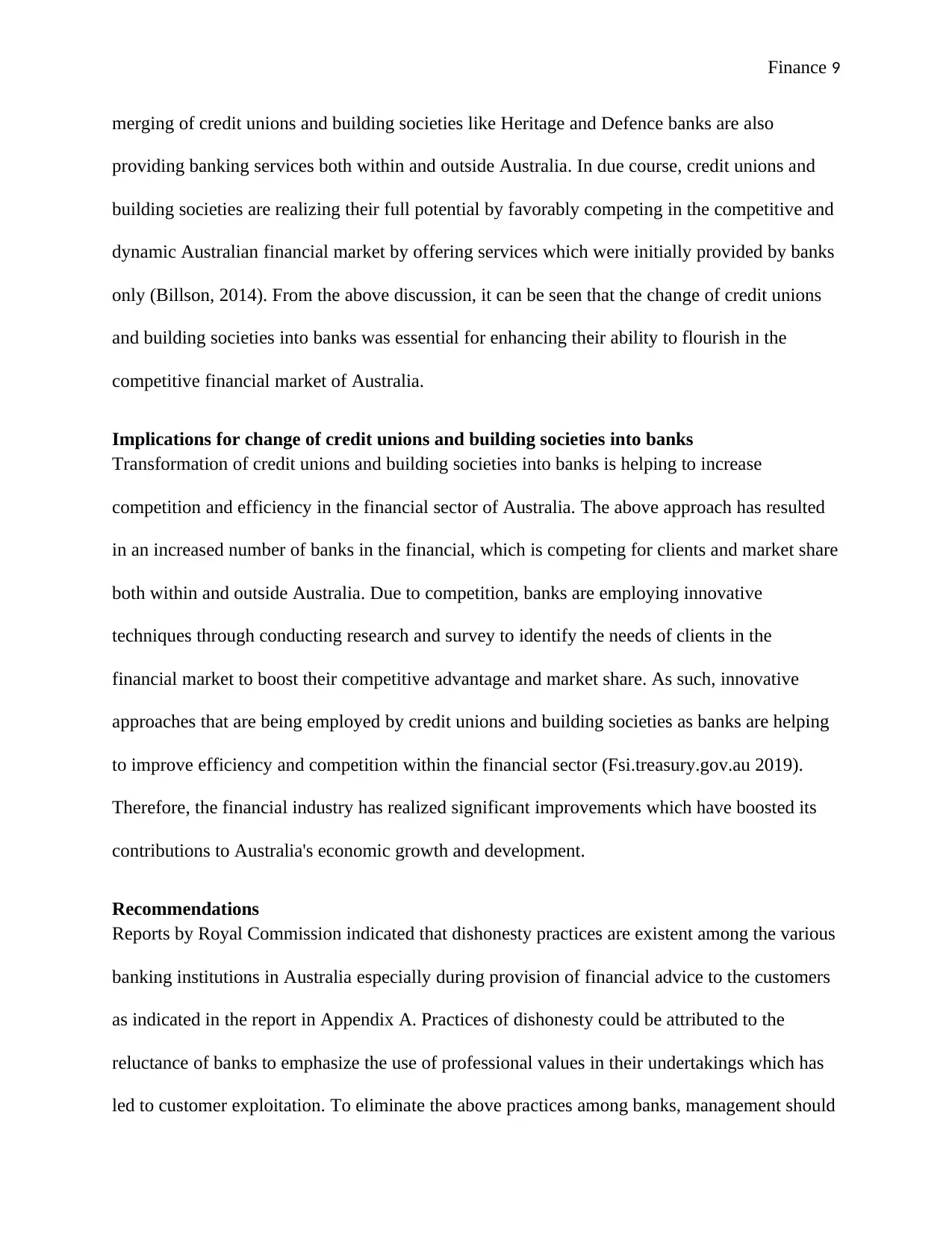
Finance 9
merging of credit unions and building societies like Heritage and Defence banks are also
providing banking services both within and outside Australia. In due course, credit unions and
building societies are realizing their full potential by favorably competing in the competitive and
dynamic Australian financial market by offering services which were initially provided by banks
only (Billson, 2014). From the above discussion, it can be seen that the change of credit unions
and building societies into banks was essential for enhancing their ability to flourish in the
competitive financial market of Australia.
Implications for change of credit unions and building societies into banks
Transformation of credit unions and building societies into banks is helping to increase
competition and efficiency in the financial sector of Australia. The above approach has resulted
in an increased number of banks in the financial, which is competing for clients and market share
both within and outside Australia. Due to competition, banks are employing innovative
techniques through conducting research and survey to identify the needs of clients in the
financial market to boost their competitive advantage and market share. As such, innovative
approaches that are being employed by credit unions and building societies as banks are helping
to improve efficiency and competition within the financial sector (Fsi.treasury.gov.au 2019).
Therefore, the financial industry has realized significant improvements which have boosted its
contributions to Australia's economic growth and development.
Recommendations
Reports by Royal Commission indicated that dishonesty practices are existent among the various
banking institutions in Australia especially during provision of financial advice to the customers
as indicated in the report in Appendix A. Practices of dishonesty could be attributed to the
reluctance of banks to emphasize the use of professional values in their undertakings which has
led to customer exploitation. To eliminate the above practices among banks, management should
merging of credit unions and building societies like Heritage and Defence banks are also
providing banking services both within and outside Australia. In due course, credit unions and
building societies are realizing their full potential by favorably competing in the competitive and
dynamic Australian financial market by offering services which were initially provided by banks
only (Billson, 2014). From the above discussion, it can be seen that the change of credit unions
and building societies into banks was essential for enhancing their ability to flourish in the
competitive financial market of Australia.
Implications for change of credit unions and building societies into banks
Transformation of credit unions and building societies into banks is helping to increase
competition and efficiency in the financial sector of Australia. The above approach has resulted
in an increased number of banks in the financial, which is competing for clients and market share
both within and outside Australia. Due to competition, banks are employing innovative
techniques through conducting research and survey to identify the needs of clients in the
financial market to boost their competitive advantage and market share. As such, innovative
approaches that are being employed by credit unions and building societies as banks are helping
to improve efficiency and competition within the financial sector (Fsi.treasury.gov.au 2019).
Therefore, the financial industry has realized significant improvements which have boosted its
contributions to Australia's economic growth and development.
Recommendations
Reports by Royal Commission indicated that dishonesty practices are existent among the various
banking institutions in Australia especially during provision of financial advice to the customers
as indicated in the report in Appendix A. Practices of dishonesty could be attributed to the
reluctance of banks to emphasize the use of professional values in their undertakings which has
led to customer exploitation. To eliminate the above practices among banks, management should
⊘ This is a preview!⊘
Do you want full access?
Subscribe today to unlock all pages.

Trusted by 1+ million students worldwide
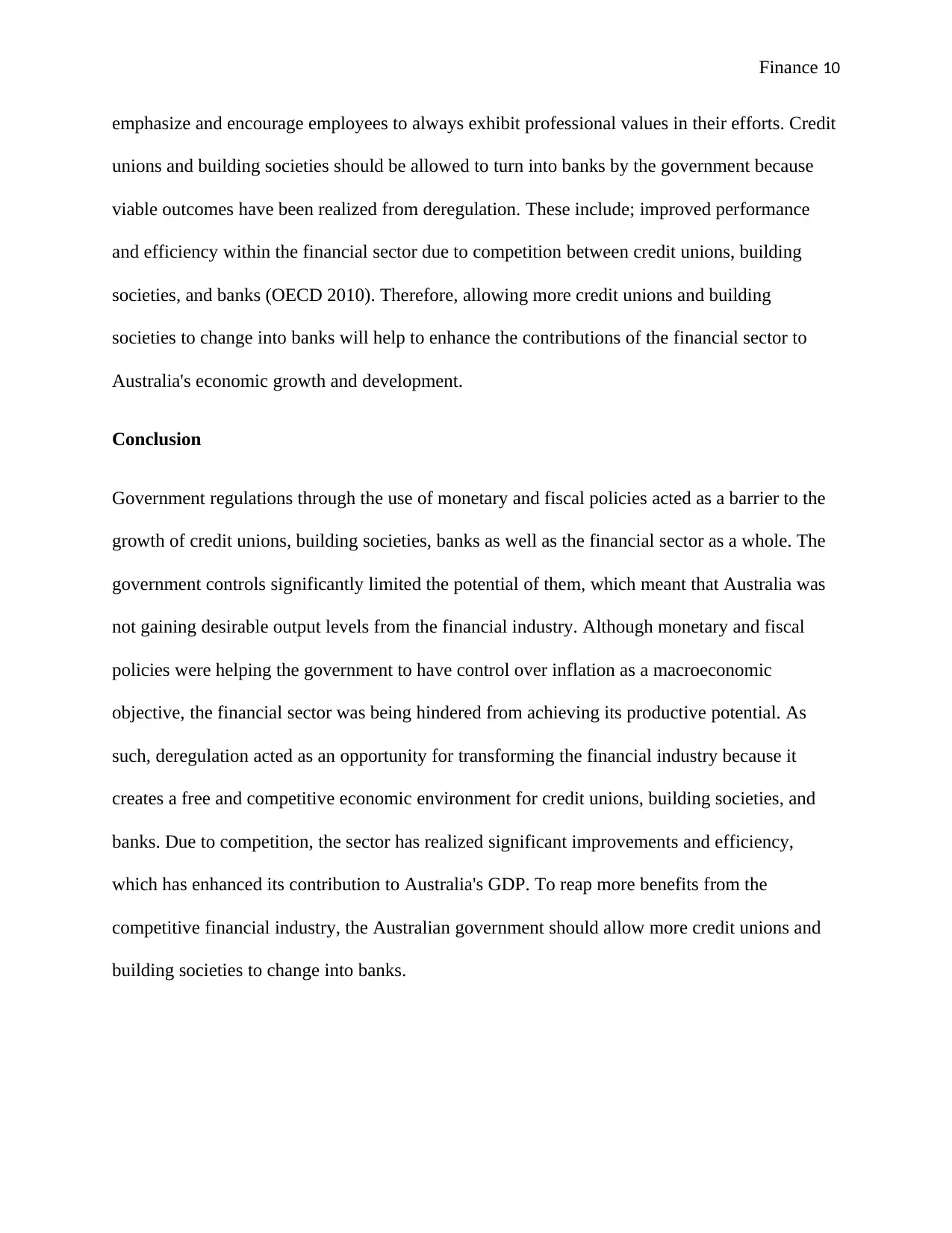
Finance 10
emphasize and encourage employees to always exhibit professional values in their efforts. Credit
unions and building societies should be allowed to turn into banks by the government because
viable outcomes have been realized from deregulation. These include; improved performance
and efficiency within the financial sector due to competition between credit unions, building
societies, and banks (OECD 2010). Therefore, allowing more credit unions and building
societies to change into banks will help to enhance the contributions of the financial sector to
Australia's economic growth and development.
Conclusion
Government regulations through the use of monetary and fiscal policies acted as a barrier to the
growth of credit unions, building societies, banks as well as the financial sector as a whole. The
government controls significantly limited the potential of them, which meant that Australia was
not gaining desirable output levels from the financial industry. Although monetary and fiscal
policies were helping the government to have control over inflation as a macroeconomic
objective, the financial sector was being hindered from achieving its productive potential. As
such, deregulation acted as an opportunity for transforming the financial industry because it
creates a free and competitive economic environment for credit unions, building societies, and
banks. Due to competition, the sector has realized significant improvements and efficiency,
which has enhanced its contribution to Australia's GDP. To reap more benefits from the
competitive financial industry, the Australian government should allow more credit unions and
building societies to change into banks.
emphasize and encourage employees to always exhibit professional values in their efforts. Credit
unions and building societies should be allowed to turn into banks by the government because
viable outcomes have been realized from deregulation. These include; improved performance
and efficiency within the financial sector due to competition between credit unions, building
societies, and banks (OECD 2010). Therefore, allowing more credit unions and building
societies to change into banks will help to enhance the contributions of the financial sector to
Australia's economic growth and development.
Conclusion
Government regulations through the use of monetary and fiscal policies acted as a barrier to the
growth of credit unions, building societies, banks as well as the financial sector as a whole. The
government controls significantly limited the potential of them, which meant that Australia was
not gaining desirable output levels from the financial industry. Although monetary and fiscal
policies were helping the government to have control over inflation as a macroeconomic
objective, the financial sector was being hindered from achieving its productive potential. As
such, deregulation acted as an opportunity for transforming the financial industry because it
creates a free and competitive economic environment for credit unions, building societies, and
banks. Due to competition, the sector has realized significant improvements and efficiency,
which has enhanced its contribution to Australia's GDP. To reap more benefits from the
competitive financial industry, the Australian government should allow more credit unions and
building societies to change into banks.
Paraphrase This Document
Need a fresh take? Get an instant paraphrase of this document with our AI Paraphraser

Finance 11
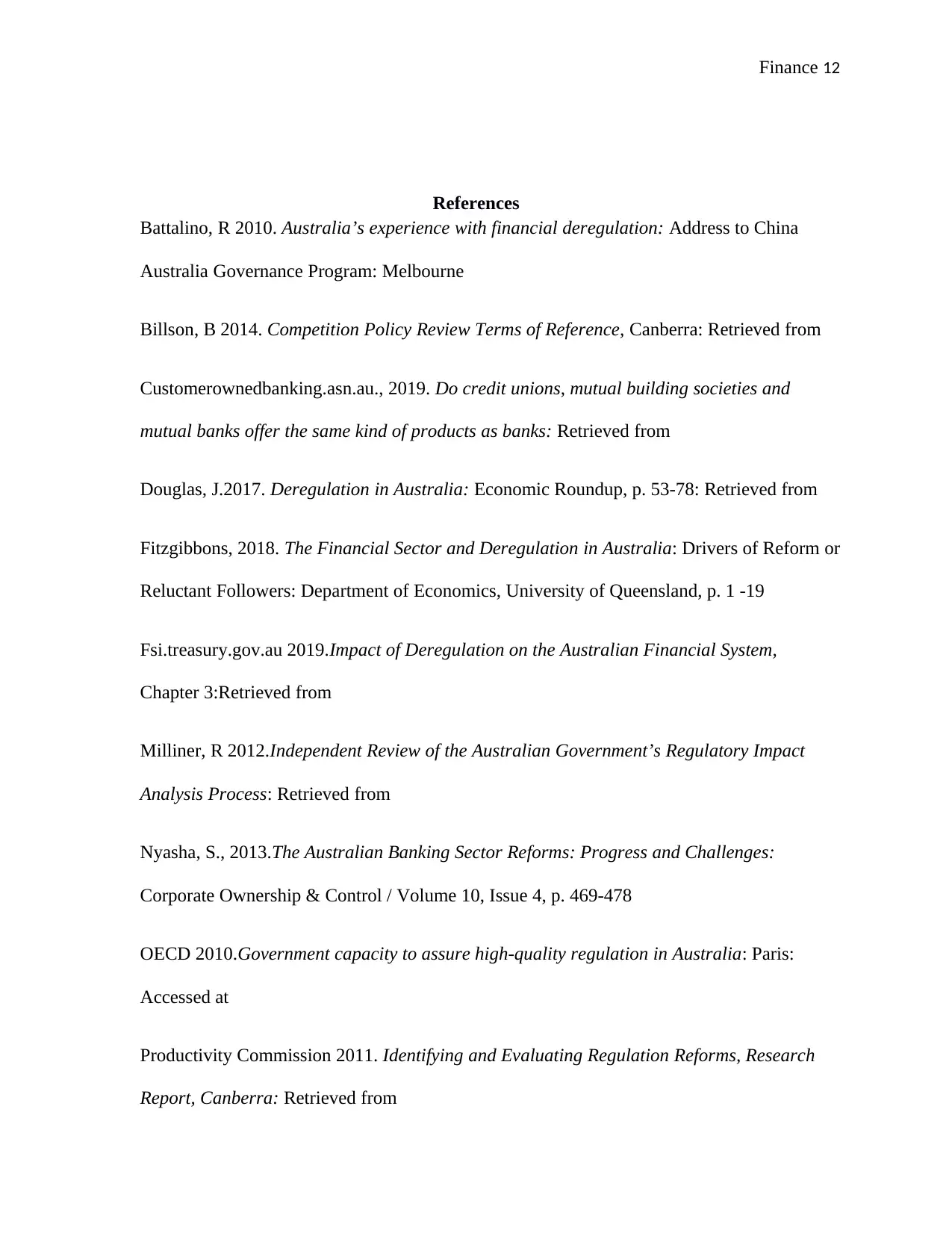
Finance 12
References
Battalino, R 2010. Australia’s experience with financial deregulation: Address to China
Australia Governance Program: Melbourne
Billson, B 2014. Competition Policy Review Terms of Reference, Canberra: Retrieved from
Customerownedbanking.asn.au., 2019. Do credit unions, mutual building societies and
mutual banks offer the same kind of products as banks: Retrieved from
Douglas, J.2017. Deregulation in Australia: Economic Roundup, p. 53-78: Retrieved from
Fitzgibbons, 2018. The Financial Sector and Deregulation in Australia: Drivers of Reform or
Reluctant Followers: Department of Economics, University of Queensland, p. 1 -19
Fsi.treasury.gov.au 2019.Impact of Deregulation on the Australian Financial System,
Chapter 3:Retrieved from
Milliner, R 2012.Independent Review of the Australian Government’s Regulatory Impact
Analysis Process: Retrieved from
Nyasha, S., 2013.The Australian Banking Sector Reforms: Progress and Challenges:
Corporate Ownership & Control / Volume 10, Issue 4, p. 469-478
OECD 2010.Government capacity to assure high-quality regulation in Australia: Paris:
Accessed at
Productivity Commission 2011. Identifying and Evaluating Regulation Reforms, Research
Report, Canberra: Retrieved from
References
Battalino, R 2010. Australia’s experience with financial deregulation: Address to China
Australia Governance Program: Melbourne
Billson, B 2014. Competition Policy Review Terms of Reference, Canberra: Retrieved from
Customerownedbanking.asn.au., 2019. Do credit unions, mutual building societies and
mutual banks offer the same kind of products as banks: Retrieved from
Douglas, J.2017. Deregulation in Australia: Economic Roundup, p. 53-78: Retrieved from
Fitzgibbons, 2018. The Financial Sector and Deregulation in Australia: Drivers of Reform or
Reluctant Followers: Department of Economics, University of Queensland, p. 1 -19
Fsi.treasury.gov.au 2019.Impact of Deregulation on the Australian Financial System,
Chapter 3:Retrieved from
Milliner, R 2012.Independent Review of the Australian Government’s Regulatory Impact
Analysis Process: Retrieved from
Nyasha, S., 2013.The Australian Banking Sector Reforms: Progress and Challenges:
Corporate Ownership & Control / Volume 10, Issue 4, p. 469-478
OECD 2010.Government capacity to assure high-quality regulation in Australia: Paris:
Accessed at
Productivity Commission 2011. Identifying and Evaluating Regulation Reforms, Research
Report, Canberra: Retrieved from
⊘ This is a preview!⊘
Do you want full access?
Subscribe today to unlock all pages.

Trusted by 1+ million students worldwide
1 out of 14
Related Documents
Your All-in-One AI-Powered Toolkit for Academic Success.
+13062052269
info@desklib.com
Available 24*7 on WhatsApp / Email
![[object Object]](/_next/static/media/star-bottom.7253800d.svg)
Unlock your academic potential
Copyright © 2020–2025 A2Z Services. All Rights Reserved. Developed and managed by ZUCOL.




